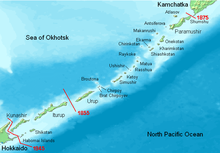5th Regional Army
|
5th Regional Army |
|
|---|---|
| active | March 16, 1944 to August 15, 1945 |
| Country |
|
| Armed forces |
|
| Armed forces |
|
| Branch of service | infantry |
| Type | army |
| Strength | approx. 200,000 |
| Insinuation | Daihon'ei |
| Location | Sapporo |
| Nickname | Tatsu ( 達 , "reaching") |
| Butcher | Pacific War |
| Supreme command | |
| list of | Commander in chief |
The 5th Regional Army ( Japanese 第 5 方面軍 , Dai-go hōmengun ) was from 1944 to 1945 one of the regional armies of the Imperial Japanese Army . Your Tsūshōgō code (military code name) was Achievement ( 達 , Tatsu ).
history
The Daihon'ei ( Imperial Headquarters of the Army and the Navy ) set up on March 16, 1944 the 5th Regional Army under the command of General Higuchi Kiichirō on Hokkaidō from the previous Northern Army . This was responsible for the protection of Hokkaidōs, the Kuril Islands and southern Saxony . To her was the 27th Army , five infantry - divisions , two self-employed mixed brigades and other smaller units available (together about 200,000 men), inter alia, in the fortress Soya , Fort Tsugaru and fortress Muroran served. After the Japanese surrendered the Aleutians in 1943, Paramushiru was the front line in the north of the Kuril Islands . In 1944, about 48,000 defensive men were posted on Paramushiru and Shumschu . As a result of the Allied offensive in the South Pacific , however, more and more troops were withdrawn and in August 1945 the total strength of the 5th Regional Army had been reduced to around 125,000 men. About 25,000 of them, mainly soldiers of the 91st Division , were stationed in the north of the Kuril Islands. The 89th Division was on Etorofu , Kunashiri and the southern Kuril Islands. The two other large units of the 5th Regional Army, the 42nd Division ( Wakkanai ) and the 7th Division ( Kushiro ), were on Hokkaidō and had, including other smaller units, a strength of about 40,000 men. The 88th Division was with 19,000 men and 10,000 reservists in southern Sakhalin .
Operation August Storm

In the neutrality pact between Japan and the Soviet Union of April 13, 1941, both contracting parties entered into a commitment to respect the mutual territorial integrity and inviolability. On April 5, 1945, the Soviet Union announced that it would no longer renew the contract, so that it would become invalid on April 25, 1946. On August 8, 1945, the Soviet Union declared war on Japan and began a large-scale offensive ( Operation Auguststurm ), initially on the Asian continent. On August 18, 1945, at 4:30 a.m., Soviet marines crossed the narrow waterway from Kamchatka to Shimushu Island, on which the 91st Division was located. The Soviet marines used 16 American LCI (L) - Landing Craft, Infantry (Large) for the landing, each bringing about 180 men 10 knots to the landing target. Even so, the taking of Shimushu claimed the lives of 1,567 Soviet and 1,018 Japanese soldiers by August 21, just days before the end of World War II .
The Tokyo Army Headquarters allowed the commanding general of the 5th Regional Army to negotiate surrender, which took place for the garrisons on Shumushu, Paramushiru and Onekotan on the evening of August 19.
In September 1945 the 5th Regional Army was disbanded.
Commander in chief
commander
| Surname | From | To | |
|---|---|---|---|
| 1. | Lieutenant General Higuchi Kiichirō | March 16, 1942 | August 21, 1945 |
Chiefs of Staff
| Surname | From | To | |
|---|---|---|---|
| 1. | Major General Kimura Matsujirō | March 16, 1942 | December 26, 1944 |
| 2. | Major General Hagi Saburō | December 26, 1944 | August 21, 1945 |
Subordinate units
The 5th Regional Army was composed as follows on March 16, 1944:
-
27th Army (approx. 80,000 men)
- 42nd division
- 91st division (*)
- more small units
- 7th division
- 88th division
- 89th Division
- 101st Independent Mixed Brigade
- 129th Independent Mixed Brigade
(*) Erected on April 12, 1945
literature
- Victor Madej: Japanese Armed Forces Order of Battle, 1937-1945. Game Publishing, 1981, OCLC 833591372 , OCLC 833591376 .
- Philip Jowett: The Japanese Army 1931-1945 (1). Osprey Publishing, 2002, ISBN 978-1-84176-353-8
- Steven Zaloga: Defense of Japan 1945 (Fortress). Osprey Publishing, 2010, ISBN 978-1-84603-687-3
- David Glantz: Soviet Operational and Tactical Combat in Manchuria, 1945: "August Storm". Routledge, 2004
Web links
- 総 軍 ・ 方面軍 . Organization of IJA,accessed January 2, 2015(Japanese).
- List of Higher Echeron Army Headquarters. Organizations of IJA & N, accessed January 1, 2015 .
- David Glantz: Soviet Operational and Tactical Combat in Manchuria, 1945: 'August Storm'. Retrieved May 9, 2015 .